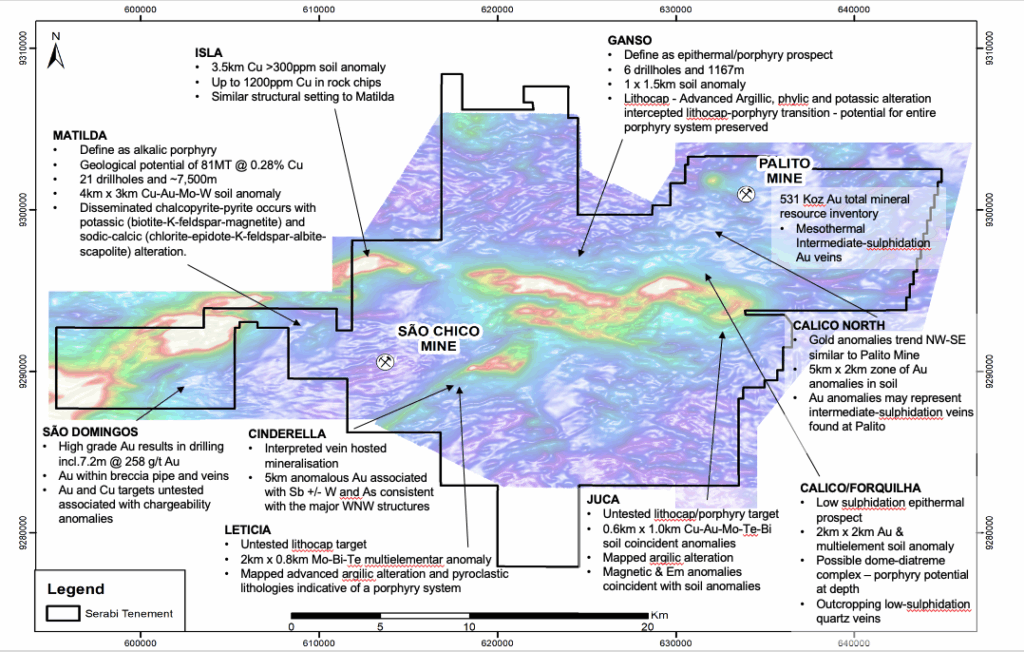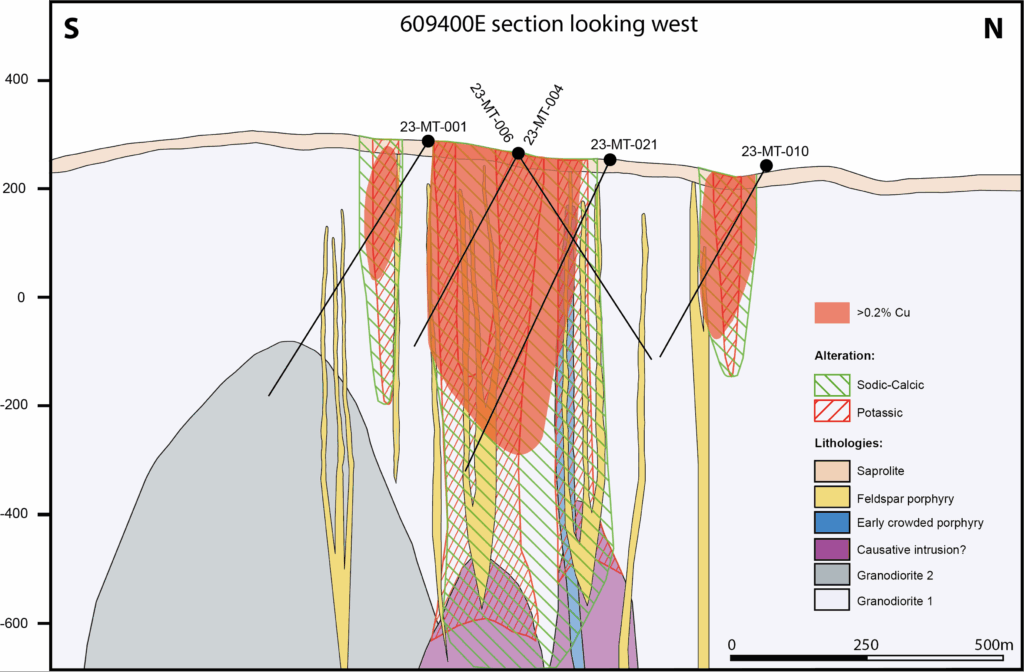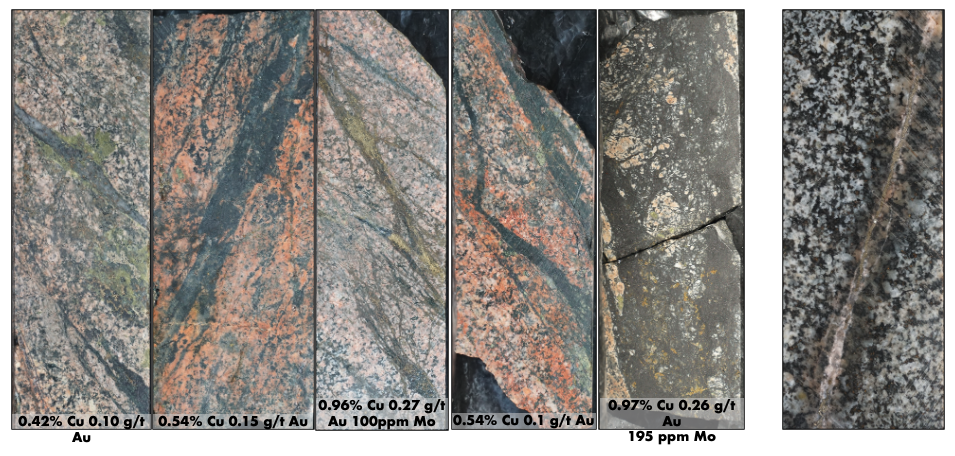
Exploration
The Tapajós region is a highly prolific but underexplored mineral province where, in recent years, different companies have settled and started production.
Serabi has been established in the Tapajos Province for over 20 years and is made up of a team that knows the geological environment in addition to:
- Two mines in production – Coringa and Palito
- Stable production of around 30-40Moz in the last 10 years and a plan to increase to>40Koz in 2025 and 55-60Koz in 2026.
- 90,000ha of tenements around the Palito Complex and Coringa project, located close to existing infrastructure.
- Several targets were discovered for gold and copper including a porphyry with geological potential of 80Mt @ 0.28% Cu.
- A hub-and-spoke approach allows discoveries to be quickly transformed into mines at low cost.
- A robust exploration programme is in progress for 2025. It includes five drill rigs in projects aiming resource addition at known orebodies extensions and new IP targets at Palito, 60km of ground IP survey in Coringa, and regional reconnaissance mapping at 2024 prioritized targets.

Serabi has been executing significant systematic exploration on its Palito and Coringa tenement package:
- Airborne geophysics and magnetics across the whole tenement in the Palito complex
- Ground IP to delineate targets near the Palito and Coringa mines.
- Intense soil geochemistry covering 70% of the company’s ground
- Geological mapping and interpretation to evaluate the geochemical/geophysical targets to prioritize resources for further drilling
The total investment in exploration in Serabi for 2025 is estimated at $ 9 M focused on resource addition aiming for organic growth and target generation to move the projects pipeline and increase the LOM.
Soil geochemistry associated with structural interpretation has guided the exploration team to define the exploration targets and rank.
Soil samples previously analysed only for gold at Coringa tenements have been reanalysed for multielement aiming for a better understanding of the geological setting and potential.
The Toucano prospect, 30km from the Palito plant was drilled in 2021 and intercepted 7.15m at 258g/t, one of the top ten intercepts for a TSX-listed equity for the year. In 2024 Serabi continue drilling, The next steps include an economic assessment and if positive, drilling for indicated resources.
The Coringa structural and geochemical anomalies define several parallel trends within over 30km of geochemical anomalies. These trends were drilled over the years and become quiet in the last 5 years, returning in 2025 with several positive intercepts and the potential of new high-grade economic zones. For 2025, 16.000 metres were programmed and are in progress at Coringa.
At Palito the interpretation of the IP survey executed in 2024 generates several targets that have been drilled in 2025. For Palito brownfields 14,000 metres of diamond drilling were budgeted and are in progress.
The Tapajós Gold Province is located in the western portion of Pará State, central northern Brazil, and covers a total of some 100,000 km2. The Tapajós is in the southern-central portion of the Amazon Craton, generally termed the Brazilian Shield, as opposed to the northern portion of the Craton, referred to as the Guyanian Shield, and extends into the littoral countries of the northern South American continent.
The Brazilian Shield is nucleated on the Archaean granite-greenstone terrain of the Carajás-Imataca Province in eastern Pará State, and progressively becomes younger and shallower towards the west, grading into granite dominated then into granite-volcaniclastic terrain of Paleoproterozoic age rocks of the eastern Amazonas State. In the Jardim do Ouro region lithologies are dominated by granitoids of the Paleoproterozoic age.
The Tapajós Province represents a tectonically controlled geological evolution attributed to the Orosirian Proterozoic period, comprising four plutonic events, over a 140 Ma period.
In the Tapajós Province, two main units form the basement, the Paleoproterozoic Cuiú-Cuiú metamorphic suite (2.0 -2.4 Ga) and the Jacareacanga metamorphic suite (>2.1 Ga). The Jacareacanga is considered to be the older suite; however, the relationship is not yet well defined.
The Jacareacanga suite is comprised of a sedimentary-volcanic sequence, deformed and metamorphosed to a regional greenschist facies, with units of sericitic and chloritic schists and rare banded iron formations.
The Cuiú-Cuiú suite, which is the basement for the Palito area, is comprised of orthogneisses of dioritic to granodioritic composition, locally monetized, deformed tonalitic granitoids and enclaves or rafts of amphibolites.
Both the Cuiú-Cuiú and Jacareacanga suites are intruded by monzogranites of the Paráuari suite (2000 -1900 Ma), tonalites, diorites, and granodiorites of the Tropas suite (1907 Ma -1898 Ma) and granites and granodiorites of the Creporizão suite (1893 -1853 Ma). These three intrusive suites are considered to have calc-alkaline affiliations and may be considered remnants of a magmatic back-arc system interpreted for the region.
Regional structural analysis of the Tapajós Province has identified various compressive deformation regimes including ductile, brittle-ductile, and brittle. The deformation is interpreted to have occurred as two separate events, the first compressive event, with peak deformation around 1.96 Ma, resulting in the development of ductile and brittle-ductile deformation regimes. The second event occurring at 1.88 Ma resulted in brittle deformation. These events resulted in major north-south, north-west-south east, and east-west lineament sets.
The geometry of the lineament and structures are compatible with a combination of Riedel fracturing and strike-slip fault systems, where the principle vector of compression is oriented in an east-west and ENE-WSW direction.
Gold mineralisation is not restricted to a particular suite, with deposits located in all suites including; Cuiú-Cuiú Suite (Cuiú-Cuiú), Paráuari Suite (Tocantinzinho, São Jorge and Palito), Tropas Suite (Ouro Roxo), Salustiano and Bom Jardim Formation (V-series deposits, Bom Jardim), Maloquinha Suite (Mamoal). Gold mineralisation associated with quartz and hydrothermal alteration assemblages is reported in all the fracture orientations of the Reidel system and is dominated by fractures oblique to the principle strike-slip shear orientation.
The geometry of the lineament and structures are compatible with a combination of Riedel fracturing and strike-slip fault systems, where the principle vector of compression is oriented in an east-west and ENE-WSW direction.
Gold mineralisation is not restricted to a particular suite, with deposits located in all suites including; Cuiú-Cuiú Suite (Cuiú-Cuiú), Paráuari Suite (Tocantinzinho, São Jorge and Palito), Tropas Suite (Ouro Roxo), Salustiano and Bom Jardim Formation (V-series deposits, Bom Jardim), Maloquinha Suite (Mamoal). Gold mineralisation associated with quartz and hydrothermal alteration assemblages is reported in all the fracture orientations of the Reidel system and is dominated by fractures oblique to the principle strike-slip shear orientation.
The Tapajós region has only recently started to be the subject of systematic exploration and therefore the artisanal miners provide a valuable exploration tool with a significant portion of the 7 million ounces of hard rock resource identified to date close to and/or underlying historic artisanal operations. However, there is much that the artisanal miners will miss as they seek out the “low-hanging fruit” where ease of access and topography suited to the needs of hydraulic mining are important. Structures that do not outcrop at the surface will be missed but may be identified by Serabi’s extensive exploration approach, presenting a significant opportunity for the Company.
The gold occurrences identified in the region to date have all been associated with sulphide mineralisation which is amenable to geophysical exploration methods. Serabi has therefore undertaken airborne electromagnetic surveys (“EM”) which identify areas of potential sulphide mineralisation and facilitate screening of large areas of its tenement. As much of the surface area of the tenement is given over to pasture or other vegetation, visible indicators that might occur in more arid regions are not present in this part of Brazil.
Not all sulphide bodies will necessarily host gold in commercial quantities, and it is for this reason that a geological data set needs to be built up before any exploration drilling is undertaken. Serabi’s geological team will conduct follow-up ground studies using a variety of tools including induced polarisation (“IP”) to measure the relative conductivity and resistivity of the area, taking stream and surface soil and rock chip samples looking for anomalous geochemical levels of gold and other indicator minerals and mapping, trenching and augur drilling to extract samples a few metres below the surface. Where a number of these coincident mineralisation indicators overlap, then a decision and priority can be established for a specific area of interest.
Over the past few years, Serabi’s systematic exploration approach has been rewarded with a number of significant opportunities, which management is keen and excited to progress. With a focus on opportunities that are generally within 10 to 20 kilometres of existing operations, this brings substantial benefit to stakeholders. The Group can leverage its infrastructure to maximise the pace of exploration advancement and, more importantly, is in the position to quickly translate exploration success into production ounces. Serabi’s tenement holding around its Palito Complex is dominated by an ESE-WNW trending regional structure, known as Mato Cobra, a structure displaying strong magnetic and radiometric anomalism. A number of Serabi’s current key targets have initially been selected where multiple electromagnetic anomalies (typically indicators of massive sulphides in the Tapajós) have coincided with the Mata Cobra.


São Domingos (1)
- Acquired in 2020.
- Located 15km to the west of the São Chico mine.
- Tenements host many rich, historic, and currently active artisanal pits.
- Serabi established the baseline geological data to properly evaluate the land package.
- The work programme included mapping and soil sampling and in late 2021, an airborne geophysical survey. In 2024 a new soil campaign was executed and a drilling programme added 13 diamond drill holes totaling 3,769m.
- The initial area of interest comprises three artisanal pits, Raimundo, Toucano, and Grota da Sangue, covering a 600m-long structure (the Toucano trend).
- Several fertile structural trends that host mineralisation similar to the Toucano trend, including the Mario Dio, Atacadao, and Messias trends. Trends are aligned northeast to southwest running parallel and spaced broadly 500-800m throughout the tenements.
- Many host historic pits extending to depths of ~30m
- The expectation is that the São Domingos tenements could yield new high-grade satellite deposits providing supplementary high-grade ore to Serabi’s existing operations.
Matilda (2)
The Matilda target is a four-kilometre by four-kilometre geochemical anomaly within which lies a two-kilometre by two-kilometre gold, copper, molybdenum, and tungsten (“Au-Cu-Mo-W”) core. This geochemical anomaly is coincident with anomalous high magnetic susceptibility associated with magnetite alteration. Mapping has identified granites with potassic, propylitic, and sericite-chlorite alteration, dacite porphyry, and quartz-sulphide veins, all of which bodes well for a bulk target. Further, Matilda sits on a topographic high, with extensive artisanal workings in surrounding rivers and drainages.
The Matilda prospect was initially tested with three drill holes in 2022.
Each hole intercepted porphyry mineralisation with average grades of >0.2% copper equivalent* from top to bottom of the hole.
Approximately 6,500 metres of diamond drilling have been completed in 21 holes at Matilda.
The copper mineralisation and hosting rocks have many characteristics that typify alkalic porphyry deposits found in Australia and Canada.
Reprocessing of data from the airborne geophysical survey completed in 2022 indicates that the positive drill results may lie within a 1.2-kilometre by 800-metre demagnetised structural zone. The zone remains untested both laterally and at depth.
In addition, deep penetrating Induced Polarisation (“IP”) and Audio-Magnetotelluric (“AMT”) geophysical programmes have been designed to complement the drilling.


Cinderella (3)
Located to the east and south east of São Chico, the Cinderella prospect is a five kilometre south west to north east trending IP and EM anomalous area with elevated gold in soil grades and artisanal workings in some of the streams that are fed from this topographical high.
Calico (5), Juca (7) and Forquilha (6)
- All are located within 5km of the Palito Complex.
- Calico is now significant, covering a 2km x 2km area in addition to Juca which has strong and constant gold grades above 30ppb within an area of 1km x 1km.
- DDs realized in Forquilha returned calcitic blades typical from an epithermal environment. The next steps include deep drilling.
- Soil samples returning values as high as 0.8g/t gold have been recorded, better than have been seen in any soils over the Palito orebody.
- A terrestrial geophysics survey using Induced Polarisation covering the Calico soil anomaly identified multiple chargeability anomalies.
- Scale and signature are very comparable to Palito orebody, where over 400koz has been mined and hosting a further 500 gold mineral resources.
- Calico Prospect and neighboring Juca and Forquilha prospects were initially identified from the interpretation of an airborne electromagnetic survey completed in 2018.
- Reconnaissance field mapping identified alteration (potassic, haematitic, and silicic) and evidence of weathered and primary sulphides in limited outcrop associated with felsic intrusive and volcanic rocks.
- Systematic grid soil sampling subsequently identified a number of cohesive multi-element geochemical anomalies of which the most significant was the Calico prospect.
- Calico prospect highlighted by a central potassically altered dacite porphyry intrusive with coincident higher temperature soil geochemistry multi-element signature of Mo-Bi-As-Te-W-Sn.
- Dacite porphyry intruding into a monzogranite is bounded by a broad 2km x 2km high gold/low antimony halo to the northwest and anomalous copper wrapping around the southern part of the intrusive core.
Ganso (4), Juca (7) and Forquilha (6)
- Each prospect presents coincident geochemical and geophysical anomalies, including EM anomalies indicating the possible presence of sulphide bodies.
Coringa :
- Exploration drilling started in 2025 and focussed on the extensions of the main gold anomalies within the main geological structures.
- Significant potential for further resource growth. 16,000 of diamond drilling in progress aiming the addition of resources. Preliminary visual intercepts showing the potential of the mineralisation extension.
- Soil sampling has been reanalysed for multielement aiming a better understanding of mineral context.
- Known continuation of the belt for at least 30 kilometres to the south.
- Numerous untested geochemical targets to the north following the strike extensions of known deposits.
- The Mato Velho area to the north is a significant untested geochemical anomaly with high grades (>20g/t) in chip samples and several artisanal trench works.



